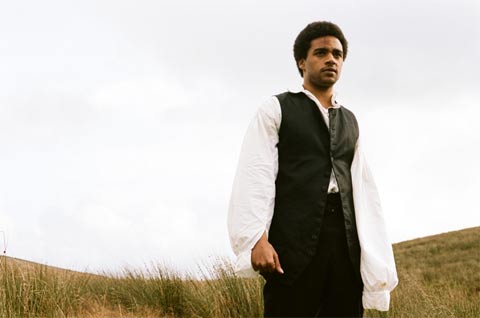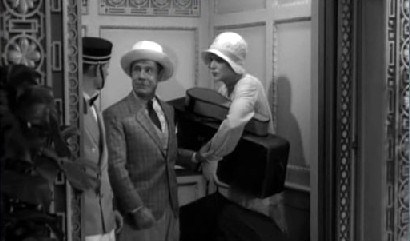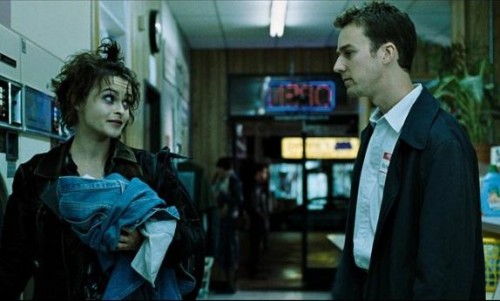This is a guest post by Brigit McCone.
The IMDb page of Woody Allen’s Match Point (2005) offers the following summary: “at a turning point in his life, a former tennis pro falls for a femme-fatale type.” The plot of Match Point: Jonathan Rhys Meyers’ former tennis pro aggressively pursues Scarlett Johansson’s sexually confident actress, begins an affair that only she expresses guilt over (though she is single, breaking up with her fiancé after her first hook-up with Meyers, while he remains engaged), then he plans and executes the cold-blooded murder of Johansson to cover his adultery. In other words, Meyers plays a classic, manipulative “psycho killer bitch” in all but gender.
The fact that Johansson’s character is nevertheless judged as a “femme-fatale type” and Meyers’ character excused as being “at a turning point in his life,” points to the real underpinnings of the femme-fatale: the assumption that female sex appeal is responsible for male violence. Her manipulative behavior may confirm the femme-fatale’s evil, but her responsibility for male violence is the core of her role, rooted in a victim-blaming lack of empathy for women. If that remains true even in 2005, it was certainly true of the ’40s and ’50s heyday of film noir.
Few people understood the logic of the femme-fatale better than Ida Lupino. Her looks, confidence and intelligence saw her typecast as a seductive “vamp” from the age of 14. Lupino became one of the iconic femme-fatales of the 1940s, breaking out as crazed villainess of They Drive By Night, followed by genre classics High Sierra, The Hard Way, and Road House. Lupino then struck out from the studio system to direct three noirs of her own: Outrage, The Hitch-Hiker, and The Bigamist, the only classic noirs made by a female auteur. Each uses a different strategy to challenge the empathy gap between spectators and female characters, and to subvert the femme-fatale trope.
Rape Culture As Ultimate Noir: Outrage
The first cinematic examination of what feminists now call “‘rape culture,” 1950’s Outrage introduces Ann Walton (Mala Powers), a character whose wholesomeness is emphasized from the film’s start. She is liked by co-workers and says of her fiancé, “I found the right one,” showcasing her mental monogamy. In a tense, expressionist sequence of shadowy yards and deserted streets, Ann is stalked by a sexual predator and caught when she swoons; it is her traditional femininity that makes her vulnerable, not transgression. Ann is constantly watched: chatting to her fiancé, she is smirked at by an old lady; when talking with a co-worker, the clenching hands of her future attacker are visible in the foreground, making the audience uncomfortably aware that we share his gaze. We, too, will be asked to watch and judge Ann throughout the film.
This surveillance of chivalry offers Ann no protection. As her future attacker insistently flirts with her, to her visible discomfort, bystanders are blank-faced and avoid eye contact. As a vulnerable woman alone at night, taxis refuse to stop for her. As her attacker closes in to rape her, the camera pulls back to a neighbor firmly shutting his window. After the rape, we are shown the averted eyes of former friends and the everyday intrusions of men, who casually grab her flinching shoulder or invade her space, an entitlement to the female body that is weaponized by Ann’s trauma. When Ann is finally triggered into striking a blow, she does not get revenge against her rapist, but attacks a random stranger who is stroking her hair and pestering her for a kiss. This sends a clear message that such pushy violations of a woman’s boundaries collectively create a triggering environment that normalizes rape. The conventions of noir, which condition the audience to accept that society is hostile and unjustly disbelieving the protagonist, are used by Lupino to shape the audience’s interpretation of rape culture.
Ann finally finds redemption through the friendship and support of Rev. Bruce Ferguson. It is visiting him alone at his house at night, and driving with him into the countryside unchaperoned, that allows him to counsel her. The fact that she is healed by ignoring society’s proprieties, and victimized when swooning in conventional feminine panic, demonstrates the irrelevance of woman’s transgressions to man’s actions. Rev. Bruce’s authority as man and as cleric is invoked to justify Ann. In the film’s climactic trial of Ann for attacking the harassing flirt, the authority of the legal system is used to hold male sexual aggression responsible for female violence, neatly reversing the “femme-fatale” formula. Rev. Bruce’s mansplaining authority presents his blistering condemnation of chivalry’s failures as an act of chivalry itself: his courtroom speech establishes rape as an epidemic social problem, “a shameful blot on our towns and cities,” excuses Ann’s actions (Rhys Meyers’ tennis coach might have been “at a turning point in his life” when he gunned down Johansson’s “femme-fatale type,” but Ann had “been suffering in her mind a long time” when she clobbered a flirt with a wrench), and indicts society for the assault – “it’s our fault, all of us” – appealing to the judge “as a man.” Of course, Rev. Bruce is not speaking “as a man” at all, but “as Ida Lupino.” Society’s dismissing of woman’s testimony as “hysterical” required Lupino to dress female perspective in a male mask for it to be heard.
Outrage is fascinating as a direct appeal from the suppressed female voice. It exposes the hypocritical underbelly of traditional chivalry, and its human cost, but it is not a fully satisfying drama. The very victim-blaming that Lupino condemns, forces her heroine into one-note wholesomeness to dodge femme-fatality. Ann often irritates viewers with her “damsel-in-distress” manner, but this only highlights how inhuman a woman had to be, to be chivalry’s “justified” victim. At the same time, the need for Rev. Bruce to project authority makes his character smug to the point of creepiness. In her next film, The Hitch-Hiker, Lupino would banish women from the screen entirely and reveal herself capable of sharp psychological subtlety.
[youtube_sc url=”https://www.youtube.com/watch?v=FCRemHI0usY”]
Why Didn’t They Just Leave Him? The Hitch-Hiker
1953’s The Hitch-Hiker opens with a bold declaration: “what you will see in the next seventy minutes could have happened to you.” We hear a woman’s scream and gunshots. A lady’s purse falls to the floor at the attacker’s feet. This opening scene establishes the villain as a killer of women, but his victim is not shown. To give her any character would be to expose that character to scrutiny. Why was she traveling alone? Why would she pick up a hitch-hiker? Why didn’t she just leave him? To convince the audience that it “could have happened to them,” the faceless woman must be replaced by all-American Roy and Gilbert, on their manly hunting trip. A man can be everyman; a woman represents only herself. Roy and Gilbert, then, must walk in the shoes of the female victim; we will experience her terror through their male masks. The film is a master class in suspense and claustrophobia, making maximal use of both cramped car and empty Mexican desert. The hitch-hiker has one eye permanently opened, so the captives can’t tell whether he is asleep or watching, piling on the paranoia as the pair squirm under his peering panopticon, until they internalize his surveillance. Roy and Gilbert are as minutely scrutinized by the hitch-hiker as Outrage‘s Ann is by society.
One of the film’s harsher comments on IMDb complains that “the two captive men are presented with innumerable opportunities to outsmart or overpower their captor, but fail to do so out of apparent cowardice or stupidity,” which actually points to the film’s central strength. Under crushing pressure, the group evolves the psychological dynamic of an abusive family. The captives’ loyalty to each other becomes an exploitable weakness that prevents them from fleeing. Roy and Gilbert gradually grow complicit in the hitch-hiker’s schemes, as they adapt to his demands and learn to anticipate and appease his rages. They miss opportunities to appeal for outside help, as they are blackmailed into silence. The Hitch-Hiker is one of the rare films that realistically captures the psychology of intimidation, letting the audience witness the group’s toxic dynamic develop over time. The intimate violence of emotional abuse emerges as an ideal subject for noir. George Cukor’s Gaslight is a strong example, but Lupino’s choice of protagonists, all-American hunting buddies, explores the dynamics of abuse as universal human psychology rather than female vulnerability. In her next film, The Bigamist, she would exploit the audience’s higher tolerance for flawed and complex male protagonists, to promote empathy for complex women.
[youtube_sc url=”https://www.youtube.com/watch?v=XIeFKTbg3Aw”]
Woman Humanizes Man Humanizes Woman: The Bigamist
On the surface, 1953’s The Bigamist presents a classic narrative of infidelity: Harry is driven, by the neglect of his careerist wife Eve, into an affair with a brassy, smart-mouthed broad, Phyllis. But Lupino’s film humanizes the stereotypes into sympathetic individuals. In the process, she demonstrates that the ideology of male unfaithfulness depends on the dehumanizing of women to make them disposable; it must be justified either by condemning the wife as cold, castrating harpy, or by dismissing the mistress as calculating femme-fatale. The climactic trial of the bigamist becomes a trial of society, just like that of Lupino’s Outrage. In the authoritative voice of the male judge, the film spells out the irony that it is no crime to commit adultery, but a crime to recognize and protect both women by marriage.
Like its hero, the film refuses to demonize either woman or to imply that they deserve to be abandoned. Joan Fontaine’s Eve is a workaholic, but she is also loving and supportive. Ida Lupino’s Phyllis reveals layers of loneliness and fragility under her brash, defensive surface. She is not trying to trap Harry, giving him the opportunity to leave even after she falls pregnant. Refreshingly, the women do not turn on each other when the bigamy is revealed, but turn their looks of hurt onto Harry at his trial. The script was written by Collier Young, Lupino’s ex-husband and professional collaborator, who was married to Fontaine at the time of shooting. Lupino’s collaboration with Fontaine, and her sympathetic portrayal of Fontaine’s Eve, is thus an act of solidarity that puts its money where its mouth is, radically rejecting cat-fight logic between women who have shared a man.
Ida Lupino exploits the audience’s willingness to identify with a male protagonist, to encourage them to see both women from the hero’s sympathetic viewpoint. Lupino herself takes the role of a woman pregnant from unmarried sex, then uses the hero’s voiceover to empathize with her character and avoid moral judgment; yet another male mask for the defense of female worth. Defying double standards, Harry takes full responsibility for his choice to sleep with Phyllis, marrying her to support their child. He is flawed, against the standard of a fully committed husband, but noble when compared with the casual exploitation of women tolerated by Lupino’s society. The result is a morally complex and ambiguous portrait of polyamory, which affirms that no human is disposable and that no “femme-fatale” is without her humanity.
[youtube_sc url=”https://www.youtube.com/watch?v=1eUmFS7ww5s”]
Ida Lupino’s career as director is an intriguing example of an actress seizing power to rebut the misogynist traditions of her own genre. In the process, she reveals noir’s natural potential to explore female psychology and experience. When her company, “The Filmmakers,” folded, she went on to be a prolific director in television, then directed 1966’s The Trouble With Angels, a sympathetic portrait of a Catholic convent school. As the only female director working in ’50s Hollywood, and as a striking artist in her own right, Ida Lupino deserves a fresh look.
Brigit McCone over-identifies with Norma Desmond in Sunset Boulevard. She writes short films, radio dramas and “The Erotic Adventures of Vivica” (as Voluptua von Temptitillatrix). Her hobbies include doodling and making bad puns out of the corner of her mouth.

































